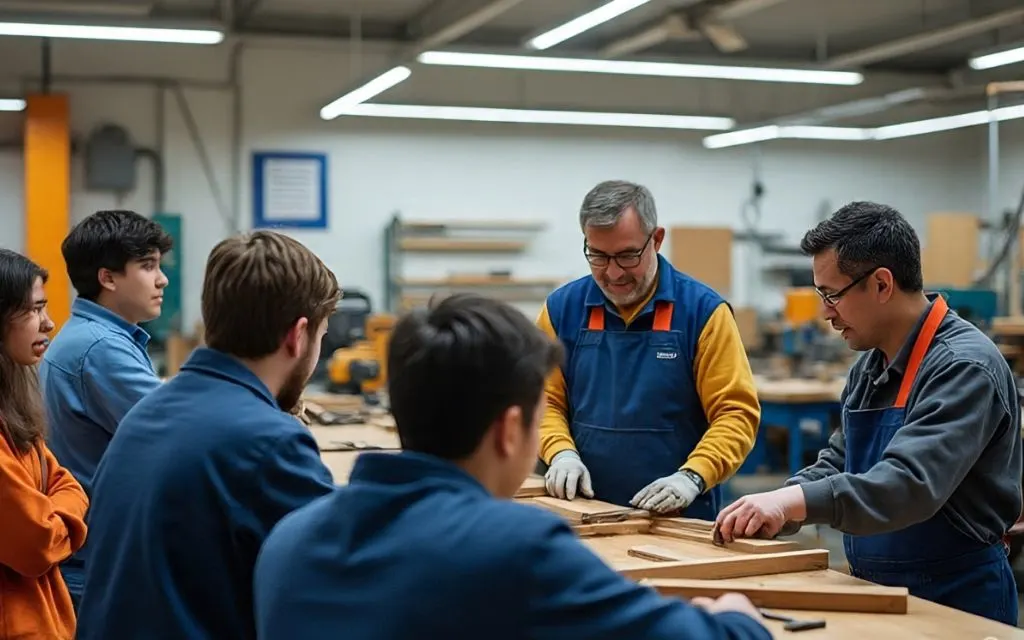In today’s rapidly changing world, technology and livelihood education plays a vital role in preparing students for real-life challenges. This subject is not just about learning theories or memorizing facts. Instead, technology and livelihood education focuses on teaching students practical skills that they can use in their daily lives and future careers. Many schools across the world have started to realize the importance of technology and livelihood education because it bridges the gap between academic learning and real-world application.
Technology and livelihood education is often referred to as TLE subject in schools. It teaches students how to perform tasks that are useful in both home and workplace settings. Through technology and livelihood education, students develop vocational skills, understand how to manage household responsibilities, and learn how to handle small businesses. This kind of education prepares learners for both employment opportunities and personal success. In this article, we will explore the different aspects of technology and livelihood education, its importance, and how it shapes the future of students.
What Is Technology and Livelihood Education?
Technology and livelihood education is a specialized subject in many school systems that focuses on both technical and practical learning. Unlike purely academic subjects, technology and livelihood education emphasizes skills that students can directly apply to their lives. It is often shortened to TLE subject, especially in the Philippines, where it forms a major part of junior high school education.
The goal of technology and livelihood education is to equip students with vocational skills and knowledge that prepare them for real-life situations. Students learn how to handle everyday tasks like cooking, sewing, farming, or even managing small businesses. In addition to manual tasks, the TLE subject includes technical education and ICT training, making it relevant for today’s digital world.
This type of education is particularly important because not all students will choose to attend college. Some will directly enter the workforce, while others may start their own businesses or work in trades. Technology and livelihood education provides students with multiple options for their future. It encourages them to develop both personal and career-related competencies.
Furthermore, technology and livelihood education promotes lifelong learning by teaching students to adapt to different situations. They gain not only technical knowledge but also life skills education, such as time management, decision-making, and resourcefulness. These skills are essential for personal development, home management, and employment readiness.
By integrating subjects like home economics, agriculture education, industrial arts, and ICT, technology and livelihood education becomes a comprehensive tool for preparing students for life beyond the classroom.
The Four Components of Technology and Livelihood Education
Technology and livelihood education is unique because it covers multiple areas of learning. Each component addresses specific skills that students need for both personal growth and professional readiness. The four components of technology and livelihood education are carefully designed to give students a broad yet practical set of competencies.
These components are:
- Home Economics – Focuses on household management and personal finance.
- Agriculture Education – Teaches students about farming, gardening, and animal care.
- Industrial Arts – Covers skills like carpentry, plumbing, and metalwork.
- Information and Communication Technology (ICT) – Involves computer literacy and basic programming.
By combining these four components, technology and livelihood education creates a balanced curriculum. Students get to experience hands-on learning while understanding how to apply their knowledge in various life situations. Whether it is cooking a healthy meal, building furniture, or using a computer, each area of the TLE subject is meant to prepare students for both daily life and future careers.
The four components also help students discover their personal interests and talents. Some may find a passion for farming through agriculture education, while others may develop technical skills in industrial arts. This variety allows students to choose their career paths with confidence.
Home Economics
Home economics is one of the most well-known parts of technology and livelihood education. It focuses on teaching students how to manage household tasks and make wise decisions related to family life. In home economics, students learn essential life skills such as cooking, sewing, budgeting, and basic health care.
One of the major lessons in home economics is food preparation. Students learn how to cook nutritious meals, plan menus, and understand the importance of hygiene in the kitchen. These cooking skills are valuable not just for personal use but also for potential careers in the food industry. Some students may become chefs, caterers, or food entrepreneurs after mastering these skills through technology and livelihood education.
Sewing is another important part of home economics. Students are taught how to repair clothes, create simple garments, and use sewing tools safely. This can lead to career opportunities in fashion design, tailoring, or garment production.
Budgeting lessons in home economics teach students how to manage household finances. They learn how to plan expenses, save money, and make informed decisions about spending. These financial management skills are critical, especially in today’s economy, where money management affects both personal and professional life.
Moreover, home economics includes lessons on personal grooming, child care, and home maintenance. This component of technology and livelihood education helps students become responsible members of their families and communities.
Agriculture Education
Agriculture education is another key area of technology and livelihood education. It teaches students how to grow plants, care for animals, and understand basic farming techniques. This is especially important in rural communities where agriculture is a primary source of income.
In agriculture education, students learn how to plant vegetables, fruits, and ornamental plants. They also study the proper ways to use gardening tools, prepare the soil, and maintain healthy crops. This knowledge helps students become aware of where food comes from and how to produce it sustainably.
Animal care is also part of agriculture education. Students learn how to feed and care for small animals such as chickens, goats, or rabbits. These lessons teach responsibility and help students understand the basics of animal farming, which can become a livelihood option.
Beyond farming and animal care, agriculture education in technology and livelihood education includes lessons on environmental management. Students are taught how to practice sustainable farming, avoid harmful chemicals, and protect natural resources. This awareness helps create a new generation of environmentally conscious individuals who understand the impact of their actions on the planet.
Learning agriculture education provides students with a valuable set of vocational skills. They can use these skills to start small farming businesses, contribute to community gardens, or work in agricultural industries. For students in rural areas, this component of technology and livelihood education is often the first step toward economic independence.
Industrial Arts
Industrial arts is one of the most hands-on components of technology and livelihood education. It teaches students various manual and technical skills related to building, crafting, repairing, and maintaining different structures or products. In this part of technology and livelihood education, students learn the basic principles of craftsmanship and develop problem-solving abilities through practical work.
Some of the common activities in industrial arts include carpentry, where students are taught how to create furniture, build simple structures, or repair household items using wood. They also learn how to handle tools such as hammers, saws, and screwdrivers safely. Understanding how to read blueprints or follow technical plans is another critical part of industrial arts, helping students develop attention to detail and technical accuracy.
Aside from woodworking, technology and livelihood education introduces students to metalwork, where they learn how to create and repair metal objects. Basic plumbing lessons teach students how to fix leaking pipes or install simple water systems. Electrical work is another essential skill under industrial arts, where learners study how to wire small circuits, replace electrical components, and practice safe electrical management.
By learning industrial arts, students also develop qualities like patience, responsibility, and creativity. They become more self-reliant, knowing they can fix things in their homes or community without always needing professional services. These skills are not only valuable for daily life but also open the door to career opportunities in construction, engineering, or manufacturing industries.
For students who may choose to pursue vocational skills after school, the industrial arts component of technology and livelihood education gives them a head start. They gain work-ready skills that are in demand in many trades and industries. Some students may become carpenters, electricians, or mechanics. Others may use these skills to start their own repair or maintenance businesses, contributing to their local economies.
Industrial arts also promotes teamwork, as students often work together on projects. This helps them develop interpersonal skills and learn how to collaborate, which are crucial traits in any workplace. Overall, industrial arts makes technology and livelihood education more meaningful by giving students real-world experiences and technical knowledge that they can use for life.
Information and Communication Technology (ICT)
As the world becomes more digital, information and communication technology (ICT) has become a central part of technology and livelihood education. ICT lessons prepare students to handle modern technology confidently. This part of the TLE subject focuses on developing computer literacy, basic programming knowledge, and understanding how technology is used in business and daily life.
In the ICT component of technology and livelihood education, students learn how to use computers for different tasks. They study how to create documents, design simple presentations, and manage spreadsheets. These basic computer operations are important for almost every job in today’s world, whether in an office setting, education, or small business management.
Students are also introduced to the basics of graphic design and simple website development. They may use design software to create posters, brochures, or advertisements for products they learn to make in home economics or industrial arts. This shows how the different areas of technology and livelihood education can connect, helping students use their skills in creative ways.
Another important part of ICT in technology and livelihood education is digital entrepreneurship. Students learn how to promote products and services online, use social media for marketing, and understand e-commerce basics. In today’s market, these digital skills are crucial for anyone planning to start a small business or work in customer service.
Cybersecurity lessons are also included in some technology and livelihood education programs. Students learn how to protect their online information, use passwords safely, and avoid scams or viruses. This is part of life skills education, preparing them to navigate the online world securely.
Additionally, students may study basic coding or computer programming. Learning to code teaches problem-solving, logic, and creativity. It also opens opportunities for students to pursue careers in technology fields like software development or IT support. Even if they do not become programmers, the exposure to technical education in ICT helps students develop a deeper understanding of how technology works.
By including information and communication technology in technology and livelihood education, schools are making sure students are not left behind in the digital age. The ICT lessons equip them with modern skills that complement the traditional lessons in home economics, agriculture education, and industrial arts.
The ICT component prepares students to meet the demands of today’s fast-paced technological world. Whether they choose to work in offices, start their own online businesses, or use digital tools for personal projects, students benefit from these essential computer skills.
Why Is Technology and Livelihood Education Important?
The importance of technology and livelihood education cannot be overstated. It equips students with practical skills training that they can use for employment or personal growth. In many schools, the TLE subject is seen as a way to prepare students for the future, especially those who may not pursue college education.
One of the key reasons why technology and livelihood education matters is because it promotes life skills education. Students learn how to survive and succeed in real-world situations. Whether it is cooking a meal, fixing a broken chair, or starting a small business, technology and livelihood education makes students capable and independent.
Another reason why technology and livelihood education is important is because it provides opportunities for vocational skills development. Not all students will work in offices or become professionals in corporate settings. Some will become carpenters, farmers, chefs, or entrepreneurs. Technology and livelihood education gives them the training they need to succeed in these roles.
Benefits of Technology and Livelihood Education
Learning technology and livelihood education offers numerous benefits to students. Here are some of the main advantages:
1. Job Readiness
Through technology and livelihood education, students become job-ready even before they graduate. They gain experience in different trades and develop skills that can help them earn income.
2. Entrepreneurial Skills
Technology and livelihood education teaches students how to start and manage small businesses. Lessons in selling products, managing money, and customer service are all part of the curriculum. This makes students more entrepreneurial and financially smart.
3. Practical Application of Knowledge
Unlike subjects that are purely theoretical, technology and livelihood education focuses on real-life tasks. Students get to practice what they learn, which makes the knowledge stick and become useful.
4. Development of Responsibility and Discipline
Technology and livelihood education teaches students the value of responsibility. Whether they are working on a cooking project, growing plants, or building something, they learn to be careful, responsible, and disciplined.
5. Life-long Skills
The lessons learned in technology and livelihood education are not just for the classroom. They are skills that students will use throughout their lives, such as budgeting, cooking, fixing things, or managing time effectively.
Challenges in Teaching Technology and Livelihood Education
While technology and livelihood education has many benefits, there are also challenges in teaching this subject. Some schools lack the proper tools and facilities to conduct practical lessons. Without the right equipment, students may not get enough hands-on experience.
Another challenge is the need for trained teachers. Technology and livelihood education requires instructors who are skilled in various trades. Training teachers in all areas of home economics, agriculture education, industrial arts, and ICT is not always easy.
Despite these challenges, schools continue to find ways to improve their technology and livelihood education programs. Government support, private sector partnerships, and community involvement can help solve these issues.
The Future of Technology and Livelihood Education
As the world changes, technology and livelihood education will also evolve. With the rise of digital technology, more schools are including advanced ICT training in their curriculum. Students are learning coding, graphic design, and online marketing alongside traditional vocational skills.
The demand for skilled workers will continue to grow, making technology and livelihood education even more important. In the future, this subject will likely include new areas such as robotics, renewable energy, and digital entrepreneurship. This will prepare students for both traditional jobs and careers in emerging industries.
Conclusion
In conclusion, technology and livelihood education is a vital part of modern schooling. It prepares students for the real world by teaching them practical skills that they can use in their daily lives and future careers. Through home economics, agriculture education, industrial arts, and ICT, students develop confidence, independence, and responsibility.
The role of technology and livelihood education goes beyond the classroom. It shapes the lives of students by giving them tools for personal success and career readiness. Whether they choose to work in a trade, start a business, or manage their homes effectively, the lessons from technology and livelihood education will guide them throughout their lives.
By promoting technology and livelihood education, schools create well-rounded individuals who are ready to face the challenges of life. As we move forward into a more skills-based economy, the importance of technology and livelihood education will only continue to grow.






